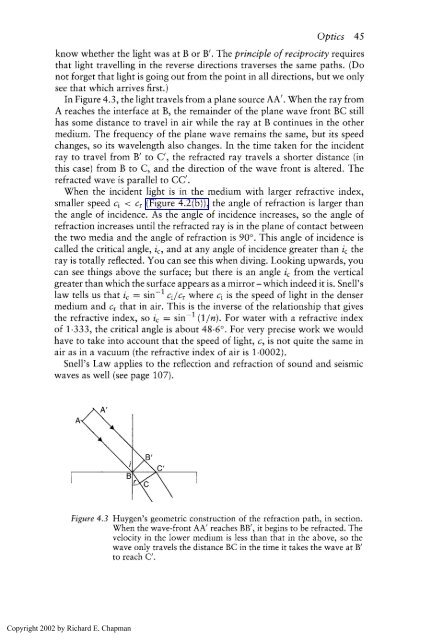Physics for Geologists, Second edition
Physics for Geologists, Second edition
Physics for Geologists, Second edition
Create successful ePaper yourself
Turn your PDF publications into a flip-book with our unique Google optimized e-Paper software.
Optics 45<br />
know whether the light was at B or B1. The principle of reciprocity requires<br />
that light travelling in the reverse directions traverses the same paths. (Do<br />
not <strong>for</strong>get that light is going out from the point in all directions, but we only<br />
see that which arrives first.)<br />
In Figure 4.3, the light travels from a plane source AA1. When the ray from<br />
A reaches the interface at B, the remainder of the plane wave front BC still<br />
has some distance to travel in air while the ray at B continues in the other<br />
medium. The frequency of the plane wave remains the same, but its speed<br />
changes, so its wavelength also changes. In the time taken <strong>for</strong> the incident<br />
ray to travel from B' to C', the refracted ray travels a shorter distance (in<br />
this case) from B to C, and the direction of the wave front is altered. The<br />
refracted wave is parallel to CC1.<br />
When the incident light is in the medium with larger refractive index,<br />
smaller speed ci < c, (Figure 4.2(b)), the angle of refraction is larger than<br />
the angle of incidence. As the angle of incidence increases, so the angle of<br />
refraction increases until the refracted ray is in the plane of contact between<br />
the two media and the angle of refraction is 90". This angle of incidence is<br />
called the critical angle, i,, and at any angle of incidence greater than i, the<br />
ray is totally reflected. You can see this when diving. Looking upwards, you<br />
can see things above the surface; but there is an angle i, from the vertical<br />
greater than which the surface appears as a mirror - which indeed it is. Snell's<br />
law tells us that i, = sin-' ci/c, where ci is the speed of light in the denser<br />
medium and c, that in air. This is the inverse of the relationship that gives<br />
the refractive index, so i, = sin-' (lln). For water with a refractive index<br />
of 1.333, the critical angle is about 48.6". For very precise work we would<br />
have to take into account that the speed of light, c, is not quite the same in<br />
air as in a vacuum (the refractive index of air is 1.0002).<br />
Snell's Law applies to the reflection and refraction of sound and seismic<br />
waves as well (see page 107).<br />
Copyright 2002 by Richard E. Chapman<br />
Figure 4.3 Huygen's geometric construction of the refraction path, in section.<br />
When the wave-front AA' reaches BB', it begins to be refracted. The<br />
velocity in the lower medium is less than that in the above, so the<br />
wave only travels the distance BC in the time it takes the wave at B'<br />
to reach C'.






